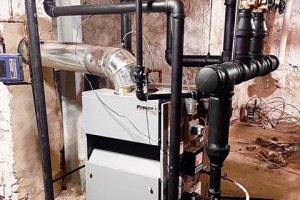
Hello, old friend. I’m writing today to say thanks, and to say farewell. This will be my last column.

Each Thursday morning, I send a free e-newsletter to more than 5,000 opt-in subscribers. It usually contains seven links to interesting stories (some of which even have to do with heating) along with my brief musings. I do this because I am curious by nature, love to share, and have no life.
A while ago, I posted a link to a story about Honeywell and the good city of Quincy, Massachusetts. Honeywell had contracted with the city in 2007 to save them energy in their buildings. The contract was for $30 million. Over the next 20 years, Quincy was supposed to save as much money on energy as the upgrades cost. It’s the sort of deal that has been made many times before, and all across the world.
Initially, there were savings, but then there were fewer saving, and the next folks to arrive were the lawyers. Surprised?
Honeywell also explained to the folks in Quincy that they couldn’t guarantee the expected savings unless Quincy paid them $22 million over the next 20 years to maintain the systems. Mayor Thomas Koch refused to do that and it was back to the lawyers.
All in all, it’s been a grand American tale, filled with hope, promise, misunderstanding, and bewilderment, but it looks like they’re working it out – and out of court, which is always a good place to work it out.
I spent time thinking about that story before I shared it with my subscribers because it seems to me that doing a deal like this is sort of like owning any sort of equipment. You have to understand how to use the stuff, and you have to realize that it will need maintenance during the next 20 years. I wondered about how complicated that maintenance was going to be in this case, and whether there would be anyone other than the Honeywell folks who could understand it all. I mean when they ask you to pony up a bit more than a million bucks a year to maintain things you has better be saving more than that amount each year for this deal to make sense.
But I could be missing something so I tossed the ball to the subscribers and asked them for their thoughts. This group is not bashful and they were more than happy to share their thoughts from the front, two of which I wanted to share with you here because they’re so well stated.
The first came from a contractor:
“I blame human nature. The key part of the contract was a requirement that Honeywell ‘maintain’ the systems for 20 years. What this enables them to do is combat human nature, which dictates that whenever the facility gets a complaint about comfort or an inconvenience they do whatever they have to do in order for their phone to stop ringing. For example, Mary Jones complains her office is always too cold. They prohibit her from using a space heater under her desk after they ‘spent all that money’ to make the building efficient. Space heaters waste energy. So Jimmy the Custodian gets tired of hearing the complaints and he ‘tweaks’ the news building-management system. Mary is now warm and Jimmy can go back to his regular routine.
“Honeywell's main role in the building during those 20 years would have been to enforce economical operation of the HVAC, lighting controls, etc. to combat human nature and protect their contract, period.”
Combating human nature is not an easy task, and I suppose that’s a large part of why it costs what it cost. But getting back to the numbers, there’s this from one of the sharpest engineers I know, who wrote:
“I see this all the time with controls retrofits and associated equipment change-outs. Regarding equipment, we know that unless a boiler, for example, is on its last legs, or is running at under 50% efficiency with, say, five years of life left, it rarely if ever makes sense to replace that boiler based on higher potential efficiency alone. And you’d need a crystal ball to predict its date of death. Of course, if the annual cost of repair gets to a certain metric that’s going to help with the decision, but who knows if that annual cost will be the same next year?
“To replace a boiler running along at 75% efficiency, but which is at the middle of its life, I believe the cost of energy would need to be 50% higher than it currently is to even start the conversation. Due diligence says we calculate it out in each case (and each case is unique), but the results are pretty consistent. It’s a matter of degrees. No pun intended.
“Regarding controls retrofits, in general, the failure points, as I see them, are these:
“First, complexity. There’s too much sub-metering and data. No one person has the time to analyze or interpret all of this.
“Next comes simplicity. There usually aren’t enough sub-meters, which would allow a person to identify loss sectors. This could be HVAC equipment, lighting, computer loads or data centers. Basically, you want see the big pieces and use portable meters to investigate the suspected specifics.
“Then there’s the cost of maintenance. This is a very gray area. Most controls are solid-state. Sensors sometimes drift and ‘go bad; but no one knows that this happened until it shows up as a comfort complaint, or as higher energy bills. This is like driving a car forward while staring only at the rear-view mirror. But control contractors also have to feed their families and that’s why maintenance contracts are expensive. It is not unusual to have a floor-price of $10,000 per year for a single facility. And what does $833 per month buy you? A technician for a full day to deal with dozens of points in a given building.
“There is a well-known music concert hall in Boston that had a similar cost for what amounted to five sensors. No one could identify what these sensors did or what to adjust when the owner has control and can make his own adjustments. The energy costs for running the hall were high, sure, but the $10K was roughly 20% of energy costs, and guess what? That’s more than the savings they would ever get from the control system vs. what was there before. You save, but you pay it, instead of another entity.
“And how about adding new loads and demands? This is a big one. No building, let alone a city full of buildings, remains static. We often do energy retrofits for the K-12 school market. We replace unit ventilators with centralized systems. We specify ECM motors, VFDs – all the good stuff. Then someone says, ‘Let's add air conditioning!' It starts with the administrative offices because administrators work all summer long. Fair enough, everyone else enjoys AC so why not them? But then the teachers ask for it as well because they think it’s not fair for the administrators to have it and not the teachers. The next thing you know, AC is a much wider element than anyone anticipated.
“The first-year energy bills, after spending $150 per square foot to renovate, jump 50 percent, on top of the bond cost. All our disclaimers aside, they wind up resenting us. They say we didn’t tell them strongly enough about all of this, even though we told them in writing, at public and private meetings, and we copied them on the minutes of each of those meetings.
“Lastly, or rather firstly, is the relative cost of energy. Dan, we both know that the biggest expense in any building operation is salaries and benefits. In my city, I am sometimes called on as a concerned citizen because I have a certain expertise. They asked me to review an energy-savings proposal, which, at first glance, looked good and well-thought-out. The payback period was a wee bit optimistic, sure, and I knew the systems would not be maintained very well, but the basic were more or less sound.
“The point I made to the committee was that the school spent about $40,000 a year on energy and they might save maybe $5,000 a year over the standard technology with this proposal. The controls contract will cost $7,500 a year, and that immediately presents them with a negative cash flow. Moreover, there are 52 teachers and nine administrators, with a combined salary and benefits package approaching $5 million per year. We would be spending a premium of $58,000 to save 1/1000th of the salary base.
“The committee time they’re spending talking about it probably costs more than the savings they might see."
“Just some perspectives from the front.”
And, I think, valuable ones. What do you think? Love to hear from you.

Hello, old friend. I’m writing today to say thanks, and to say farewell. This will be my last column.

My six-year-old grandboy, Brendan, was in the vestibule of the diner when the bubblegum machine caught his attention. It was one of those spiral models that appeared in t...

Subdural posed a question on The Wall at HeatingHelp.com in the Strictly Steam section, where some of the sharpest knives in the drawer post every day. The question was a...